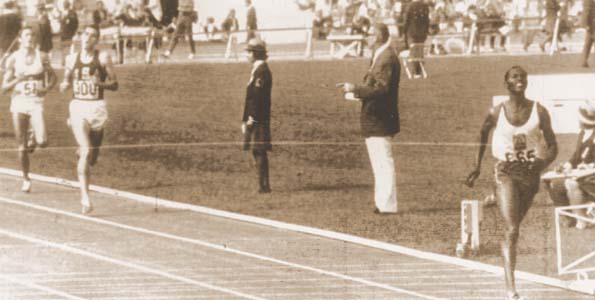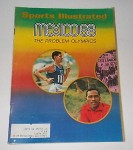Background
At the 1968 Olympics, the most highly anticipated race was the contest between American legend Jim Ryun and the Kenyan legend Kipchoge Keino. So highly anticipated was this race that prior to the Olympics, it was JIm Ryun and Kipchoge Keino who appeared on the cover of Sports Illustrated, America’s premier sports magazine which had a huge circulation.
Jim Ryun was the most famous track athlete in the USA. In 1964 Ryun while still a a junior in high school (the equivalent of Form 3 in Kenya) Ryun became the first high school runner to break four minutes for the mile, running 3:59.0 at East High School in Wichita, Kansas. The next year he clocked 3:58.3 for the mile, thus setting a high school record which lasted over 3 decades.
Between 1965 and the 1968 Olympics, Ryun had not lost a 1500m race. He had beaten Keino twice in 1966 and 1967. Each time he used his devastating finishing kick which Keino could not match despite being a strong finisher himself. Ryun could cover the last lap in 53 seconds. And in the 3 years between 1965 and 1968, Ryun had set world records in the 800m, 1500m and 1 mile. Thus going into the 1968 Olympics Ryun looked invincible and a sure bet for a gold medal.
Kipchoge Keino who at the time was in the Kenya Police, appeared not only outmatched by Ryun but he seemed overstretched by participating in too many races and was also suffering from a serious gall bladder infection. In the 10,000m with 2 laps to go he doubled over in pain due to his gall bladder infection, fell to the infield, got up and finished the race but was disqualified. Desperate to win a medal after having failed to do so in 1964, he decided to enter the 5000m four days later. He came close but ended up finishing second by 0.2 seconds. In the meantime, his gall
He was thus ordered by doctors not to run anymore and had indeed resigned himself to not running in the 1500m and settled in his sickbed to watch the race on TV. But he suddenly had a change of heart and decided to run in the race. He then took the bus to the stadium. On the way to the stadium the day of the 1500 meter race he got caught up in traffic. So Kip Keino got out of the bus and jogged the remaining mile to the stadium, arriving at the starting block only moments before the race started.
The Race
Jim Ryun had not lost any race in the 1500m for three years. Such was his dominance. His devastating finishing kick was unmatched and was the stuff of legend. Keino for his part had already experienced that kick in 1967. In addition, he had narrowly lost the 5000m race by making a tactical error: Knowing he was a high altitude athlete, he should have pushed the pace. Instead he tried to outkick Gammoundi in the last lap. It did not work and he lost by only 0.2 seconds.
Thus in the 1500m Keino was determined not to make any tactical errors. And he received help from team-mate Ben Jipcho. This was the era of team loyalty where one athlete could sacrifice his medal hopes for a ateam-mate. Jipcho did just that by setting a searing pace in the first lap. The other Americans in the race included Matt Liquori who was also a medal contender. They decided to stay at the back of the pack because they thought Jipcho’s pace was too fast and that the front runners would burn themselves out.
After 700m, Kip Keino took the lead from Jipcho and continued to set a searing pace. By the time they reached the bell, Kip Keino was 20 yards ahead of Ryun. However given Ryun’s devastating finishing kick, most observers thought he could still catch Keino. This after all was the invincible Ryun, world record holder who had not lost a race in three years. Ryun made his move with 300m to go and rapidly passed the two West Germans who were between him and Keino. However Keino who had set up a 20 yard gap continued to push the pace and Ryun was never able to reduce the gap between them. In the end Keino won with an incredible time of 3:34.86 which was an Olympic record. At first glance it does not look like an impressive time. However when you factor in the fact that it was run at a very high altitude where oxygen is thin, then you begin to realize that it was a spectacular time. In fact had that race been run at sea level, Keino may have challenged the world record. Its worth remembering that Ben Jipcho’s role in setting the early pace was key to Keino’s victory.

It was the greatest upset of the 1968 Olympics and one of the greatest upsets in the history of running, for Jim Ryun with his three world records and a 3 year unbeaten streak had seemed invincible.
Aside from the big upset, what makes Keino’s achievement amazing is the sheer number of races he had competed in even before the 1500m race as well as the fact that he had a gall bladder infection throughout. He had competed in the heats and finals for the 5000m, the 10,000m final as well as the heats and semi-finals of the 1500m. Not to mention that he had to jog to the stadium in order to run the 1500m finals
Below is the video of the race
Aftermath
The United States had very high expectations of Ryun at the 1968 Olympics. This happened at a time when long distance running was extremely popular in the United States. After the race, Ryun was attacked by some writers who believed he had let his nation down. Some even said I had let down the whole world. Ryun would later say : “ I didn’t get any credit for running my best and no one seemed to realize that Keino had performed brilliantly“.
Keino for his part gained wide acclaim in Kenya. It was around this time that a song about Keino was sung by famous musician Isaya Mwinamo. The song called “Kipchoge Keino amefaulu” (Kip Keino has succeeded) was played frequently on radio stations all over Kenya.
He became Kenya’s most famous sports personality even well into the 1980s. The stadium in Eldoret was named after him. He would later hold a variety of positions within the Kenyan sporting establishment. Keino was later named as joint Sportsman of the year in 1987 by Sports Illustrated for his charity work with his childrens home in Eldoret.
Ryun for his part went on to become a US congressman in his home
| Go to Kenya Athletics Page |

